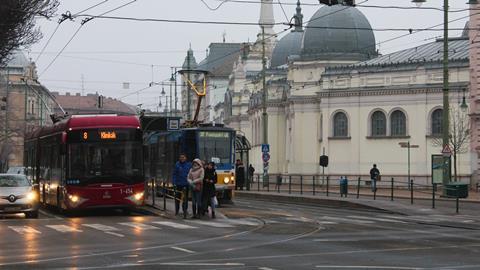With only 163 000 inhabitants, the city of Szeged in southern Hungary boasts four tram lines and six trolleybus routes. Now it is adding the country’s first tram-train project, reports Benjámin Zelki.
It is not for nothing that Szeged is called ‘the Hungarian success city for electric transport’. Despite its small size, with just 163 000 inhabitants, this southern city close to the Serbian border has retained and developed its historic tram network and expanded its trolleybus operations. Now it is hard at work on the country’s first tram-train project, which is on course to open in the second half of 2021.
Szeged has benefited from significant EU funding over the past decade or so, which has helped the city to develop its urban transport. During the EU’s 2007-13 budget period it completed a HF29·5bn project to expand its tram and trolleybus networks, while the 2014-20 budget has contributed HF22bn towards the development of the tram-train route.
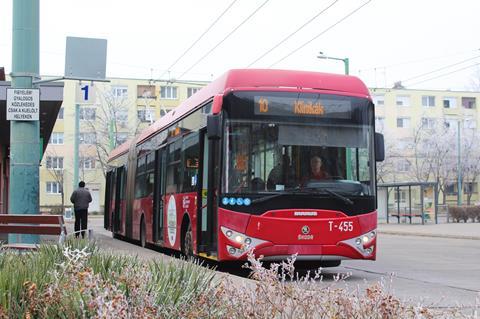
Tram and trolleybus investment
Szeged’s tram network is one of the oldest in the country, with three of the four lines having been inaugurated in 1908, during the time of the Austro-Hungarian Empire. Route 1 connects the main station at Szeged pályaudvar with the local station at Rókus on the western edge of the city. Routes 3 and 4 share tracks between Tarján in the northeast and Dugonics tér in the city centre, from where Route 3 runs to Vadaspark and route 3F continues further to Fonógyári út, while Route 4 goes to Kecskés. The branches from Dugonics tér to Fonógyári út and Kecskés are mostly single track with passing loops, but other parts of the network are double track. The trams were augmented between 1979 and 1985 by the construction of four trolleybus routes.
After several years of limited investment, Szeged was one of several Hungarian cities to benefit from EU funding for urban rail development during the EU’s 2007-13 budget period. That package enabled Budapest to build its fourth metro line, while Miskolc extended its tram route 1 and replaced all its rolling stock and Debrecen procured new trams to work its new route 2.
The Szeged electric transport project got underway in 2009 at a total cost of HF29·5bn. The city was able to reconstruct 18·3 km of existing tram tracks and build a 4·8 track-km extension through the northern part of the city, from Rókusi körút to Európa liget. About 80% of this runs on a segregated alignment with grassed tracks. Inaugurated in March 2012, the extension is worked as route 2, which has effectively absorbed the service on route 1; that has now been reduced to an hourly shuttle between Szeged pályaudvar and Rókus.
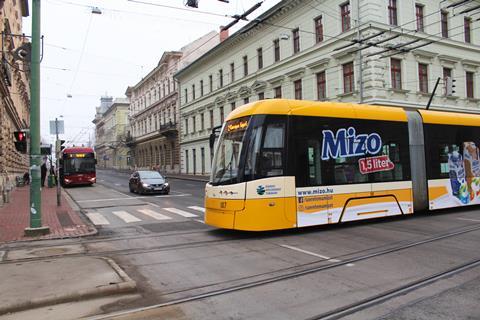
To operate the expanded network, Szeged purchased nine 100% low-floor Type 120Nb trams from PESA under a contract announced in August 2009. This was the Polish firm’s first export order. These augmented the existing fleet of 13 Tatra T6 trams dating from 1997-98, plus 18 refurbished Tatra KT4 trams, and 4 T6 trailers acquired second-hand from various German cities.
The same package funded the acquisition of 13 100% low-floor trolleybuses in January 2013. These were manufactured domestically by Ikarus, with traction equipment from Škoda Electric.
Following the launch of tram route 2, the trolleybus routes which serve the northern part of the city were reorganised. The installation of 3·7 km of new trolleybus wires as part of the investment allowed the extension of route 8 and the introduction of routes 10 and 19.
Launched in December 2013, route 10 links Tarján, Víztorony tér in the northeast with Klinikák in the city centre, replacing a diesel bus route with the same number, which had been the city’s busiest. Route 10 shares wires in the city centre with route 8 from Makkosház, which had been extended from Vidra utca to Klinikák in August 2010. June 2011 saw the launch of route 19 between Makkosház and Víztorony tér, largely following route 9 but sharing the new route 10 wires from Csillag tér to Víztorony tér. Route 9 runs between Vértói út in the north and Lugas utca to the northeast, while route 5 connects Körtöltés utca in the north with Újszeged, Gyermekkórház to the southeast. Route 7 links Bakay Nándor utca in the northwest and Újszeged, Gyermekkórház.
As well as the 13 new Škoda-Ikarus trolleybuses, Szeged has a fleet of 36 Škoda trolleybuses — 25 of Type 15Tr, four 14Tr, and seven 21Tr — plus six Solaris Trollino 12 vehicles. It also has six Mercedes Citaro diesel buses which have been converted to trolleybuses. Routes 8, 9, 10 and 19 are generally operated with articulated vehicles.
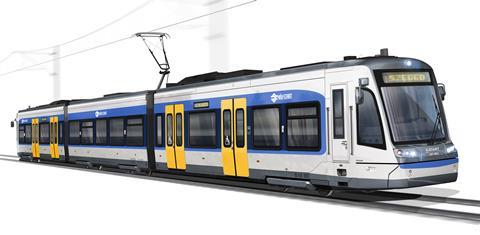
Interurban tram train
Following the improvements to Szeged’s urban public transport, the city is now working on a more ambitious project to develop a 25 km tram-train route connecting the two principal urban centres in Csongrád county: Szeged and Hódmezővásárhely.
For historical reasons, the population of the Hungarian Plain has been concentrated in a relatively small number of larger communities, rather than a spread of small villages. By 1910, Szeged already had 118 000 inhabitants, and Hódmezővásárhely had 62 000. Over the years, Szeged has grown, but its neighbour has contracted to around 43 000 residents. Employment patterns have also changed, so that today between 6 000 and 8 000 people regularly commute into Szeged each day.
Public transport handles around 60% of the traffic between the two towns, which is shared between bus and train. Because the main stations in both cities are relatively far from their central areas, around 90% of the public transport users travel by bus. Today, there are more than 80 buses in each direction connecting the two towns at peak times. Construction of the tram-train route is intended to overcome the relative isolation of the stations and switch the bulk of this traffic onto rail. The total cost is estimated at HF74·6bn, of which HF22bn is coming from the EU and the rest from the national government.
Implementation underway
Work on the tram-train project began in April 2018, with construction being undertaken in four sections. A HF9bn contract for the laying of new street-running tram tracks in both cities had been awarded in August 2017 to a local consortium of Strabag Vasútépítő and Belfry PE Kft.
At the eastern end of the route, a new section of tram line is being built through the centre of Hódmezővásárhely. This 3·3 km single-track line with passing loops diverges from the existing railway at Népkert station in the southwest of the town, running north into the central area and then looping around to terminate at the main station. There will be six stops along this section.
At the Szeged end of the route, an 800 m connection is being built from Rókus station to connect with tram route 1, which the tram-trains will use to run through the city centre before terminating at Szeged’s main station. The tram-train service is expected to take over route number 1.
The most expensive part of the project is the reconstruction of the non-electrified single-track railway between Szeged and Hódmezővásárhely to accommodate tram-train services in mixed operation with conventional passenger and freight trains. Swietelsky Vasúttechnika was awarded this HF25·6bn contract in January 2018.
The 21·3 km section between Rókus and Népkert is being modernised to raise the maximum speed from 80 km/h to 100 km/h, while two sections of route totalling about 8 km are being double-tracked. A second track is to be built between Rókus and Baktó at the western end of the railway section, and between Sártó and Kopáncs on the approach to Hódmezővásárhely. The intermediate station at Algyő is being rebuilt, and the nearby bridge over the River Tisza will also be renewed.
The original intention was that the railway would be electrified, but this was later dropped to save cost, resulting in a decision to order hybrid vehicles. Nevertheless, the line is being resignalled and the existing traffic control centre at Szeged main station will be modernised, taking the total cost of the main line works up to HF40bn.
The fourth part of the civil works is the construction of a new depot for the tram-train fleet, adjacent to MÁV’s locomotive shed and carriage sidings at Szeged Rendező. A HF5bn contract for this element was signed with Homlok Építő Zrt in May 2019.
Rolling stock is being supplied from Stadler’s Valencia plant under a HF17·6bn contract signed in November 2017. This covers the supply of eight hybrid electro-diesel CityLink vehicles, with an option for four more. They will be 37 m long with seats for 92 passengers and standing room for 124, giving a total capacity of 216. Services will be run by state-owned passenger operator MÁV-Start, the first time that Hungary’s national railway has ever managed a street-running tram line.
Once the tram-train opens, the intention is that the express bus services between the two cities will be discontinued. The current routes from Orosháza, Szentes and Békéssámson to Szeged will be cut back to Hódmezővásárhely, where passengers will change to rail.
To match the capacity of the frequent and busy bus service, tram-trains will run into Szeged at 10 min intervals at the height of the morning peak, from 06.30 to 07.10. At other times the basic service will run every 20 min during the peaks, and every 30 min off-peak. This is a significant improvement on the current two-hourly train service. The tram-trains will serve the intermediate station at Algyő, which will in future be skipped by main line trains.
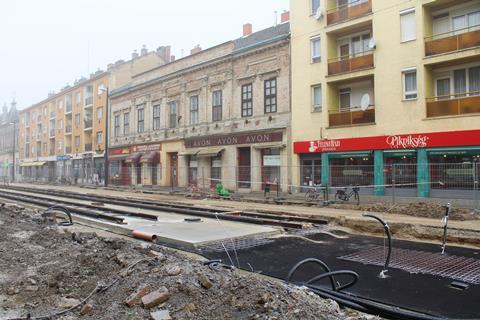
Extensions planned
Even before the core project has been completed, proposals have been floated for expansion of the tram-train service to other rail corridors radiating from Szeged. HF3bn has been included in the budget to fund planning work for three potential extensions.
One would take the tram-train route eastwards from Hódmezővásárhely to Békéscsaba, around 70 km away. The second would run east from Szeged for about 35 km to Makó, making use of the currently isolated railway that starts from Újszeged on the opposite side of the River Tisza from the city centre. That would require reinstatement of the railway bridge over the river which was destroyed in 1944, in order to reach Szeged station. The bridge was originally included in the list of EU funded projects for 2014-20, but was subsequently omitted in favour of other schemes.
The third line would run southwest for 43 km across the border to the neighbouring Serbian city of Subotica, which has a large Hungarian population. Hódmezővásárhely’s parliamentary delegate János Lázár, locally regarded as the ‘father’ of the tram-train project, who previously served in the Prime Minister’s office, has suggested that this line should not go ahead, as the costs have risen much higher than expected. However, Prime Minister Viktor Orbán confirmed that tram-train services would eventually be extended to Subotica.
Lázár has since been nominated as the government’s Commissioner for co-ordinating the reconstruction and upgrading of the Szeged – Subotica – Baja line. Work on 39 km of the route between Szeged and Subotica is expected to be completed by 2022, which would make the line suitable for tram-train operation. However, no funding has been put in place for expansion of the service beyond the initial Szeged – Hódmezővásárhely route.















